We occasionally link to goods offered by vendors to help the reader find relevant products. Some of these may be affiliate based, meaning we earn small commissions (at no additional cost to you) if items are purchased. Here is more about what we do.
Somewhat unusual for a style that has been around for more than 100 years, cast iron cookware has seen a resurgence of epic proportions in the last 10 years.
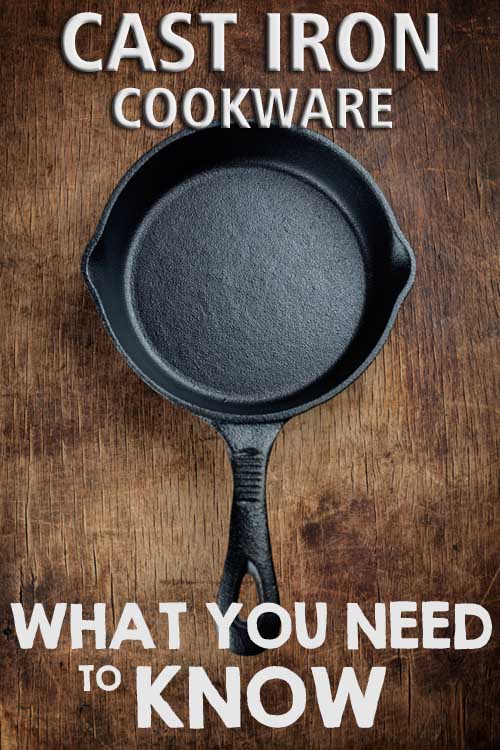
The Cookware Manufacturer’s Association reports more than a 225 percent increase in sales over the decade. More than 10 percent of cookware sales are now cast iron items– a significant increase from just 10 years before.
So what is bringing international chefs and home cooking enthusiasts back to cookware that is nearly the same today as it was when it was originally invented?
In short: staying power.
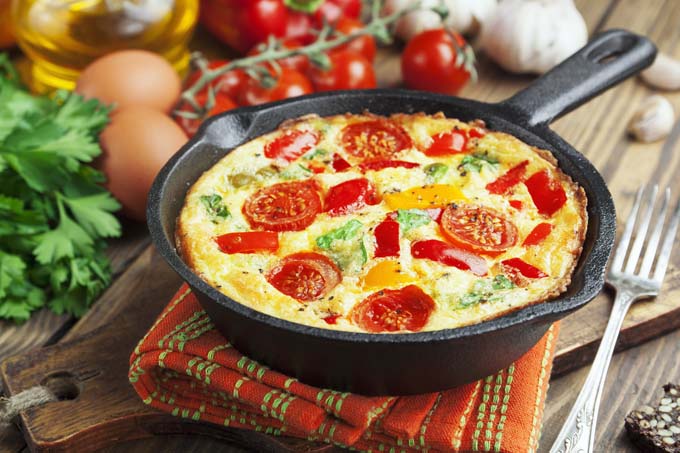
Pots, pans, waffle irons, muffin tins, loaf pans and more are just as good now as the day they were made 100 years ago. There is scarcely a product of any kind that has been manufactured by humans and can boast that kind of reputation.
History
The earliest indications of casting metal may go all the way back to China in the fourth century B.C. Ancient engineers quickly realized that the metal could be used to make weapons, and for centuries that was its primary usage.
As the efficiency of manufacturing improved, so did the creation of cast items of all kinds, and by the 1800s the ability to forge with iron was widely available.
Iron products first made their way to America in 1619, but we were not yet using the process to make cookware.
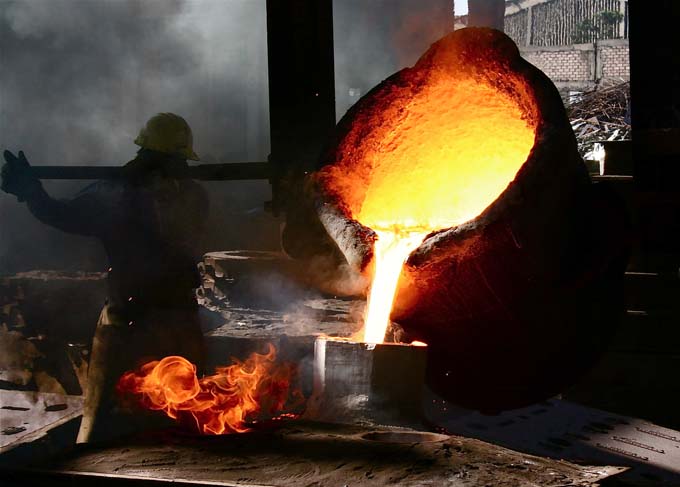
The current incarnation of the material used to create durable iron cooking products is an alloy of iron, carbon and silicon that is heated until it becomes molten.
Once it becomes a liquid, it is poured into a “cast” or mold of a pot or pan and allowed to cool. Products made using this process are solid and heavy.
They are most often made of a single block of metal rather than putting pieces together with bolts, rivets, or adhesive. This kind of metal cookware has no seams.
The most common piece of iron cookware is the Dutch oven. Despite the name, these items do not hail from the land of pigtail braids and clog shoes (a popular design for kitchen footwear, speaking of which…). The reference to Dutch in this instance means “not real” or “fake.”
Benefits
Cast cookware is often referred to as the “king” of cooking products, and reigns supreme for a number of cooking applications alongside copper, its higher priced mate and cookware “queen.”
Always enduring despite newer and more “advanced” products that have come out in the meantime, iron cooking vessels are pretty difficult to destroy.
With one good scrape of a metal spatula, Teflon pans can lose a huge amount of their nonstick promise. And that chemical coating then goes where?
Into the food the chef is preparing, and into the stomachs of all of the people who are eating it.
Cast skillets, ovens and other products can last for more then a century and can be fairly easily revitalized if purchased from a thrift store or garage sale.
Want to learn more about the cast iron choices out there, as well as other types of skillets (carbon steel, nonstick, and more)? Check out our full review and guide on the many different frying pan choices out there.
Seasoning
Cast iron offers an entirely nonstick surface, but in some cases, the owner has to work for it. “Seasoning” is the process of adding fats or oils to the surface of the cast item and then, in essence, baking it for an hour in the oven.
The oils blend with the metal and create a semi-permanent nonstick surface similar to spraying oil on a pan before cooking with it.
Despite what logic may tell you, another way to take care of cast iron is to use the same metal tools that may have destroyed other nonstick pots and pans in the past.
The scraping of the metal against the hot oil that has bonded to the pan actually enhances the bond of the patina to the pan instead of removing it.
How Does Cast Make Cooking Easier?
Iron cooking products are very versatile in comparison to many other types of cookware. Cast pots and pans can go from oven to stove back to oven before being taken directly to the table.
Unlike more common pots and pans, which can’t sustain high heat for long periods of time, iron implements are often rated up to 400ºF or higher, and won’t transfer chemicals to the food if put in the oven.
Obviously, because the items stay so hot for so long, cooks have to be careful about making the cookware too accessible to someone who might be prone to getting burned, like little kids.
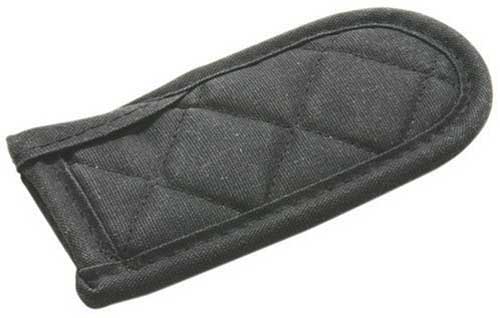
It’s a good idea to keep a good set of potholders or mittens around such as the Lodge HHMT Max Temp Handle Mitts (pictured above) when dealing with solid metal handles.
Once your food is ready to be served, many cast pots and pans can be put directly on the table as a serving dish. Users should be sure to cover the exposed parts of the pot with a potholder or trivet of some kind to avoid big and small hands from coming into contact with the hot iron.
As far as the foods that go in the pan are concerned, cooking of many kinds becomes much easier when working with iron. When the pans are preheated, browning meats can be done in a snap.
And chocolate chip cookies cooked in the pan can develop a crispy, buttery crust, while staying soft and chewy in the center.
Furthermore, the use of oil and fat in the pans adds to the nonstick coating, and scrubbing off stuck-on food becomes a relic of the past with these still current yet age-old pieces of cookware.
Considerations When Purchasing
Weight
Cast products come in all shapes and sizes, and can be purchased both new and used.
The weight is a major factor in the purchase of a satisfactory piece of cast cookware, and while not always true, the heavier items tend to hold more heat and provide a more authentic iron cooking style.
Advances in the casting of metal have led to lighter options that provide nearly the same experience, but the weight of the cast iron giants over the last century has substantially changed.
Many people will have to adjust to the heaviness when cooking with the older style of cooking product because they cannot, by any means, be considered dainty like the newer products tend to be.
If you are concerned about the weight, you may want to look into carbon steel products that are somewhat lighter, with many of the same properties. You can also read more about the differences between cast iron and carbon steel frying pans.
Handles and Knobs
While the quality of the pot or pan is important for cooking the food, being able to maneuver the device is just as important, if you want the food to actually be eaten.
Cast items must have handles or knobs that are user friendly and that don’t burn the chef easily.
Examine the construction of the items you purchase, and make sure that any place that the cook is expected to put his or her hand while cooking either has a heat-resistant cover or a potholder to go over it.
When shopping for iron pots or pans, watch for pieces that are small enough to hold easily, or that have handles on both sides.
The double handles allow the cook to balance the pot more easily when it’s being heated up or transported, and the handles reduce the chance that the pot will become too heavy for a single wrist, thus causing the cook to instinctively place a bare hand on hot metal.
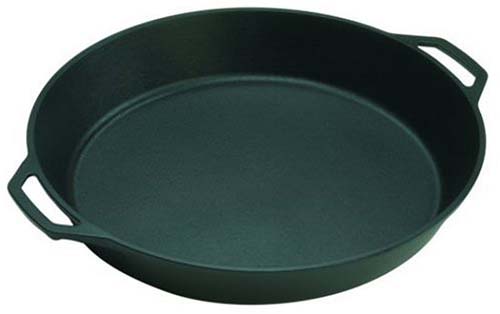
Lodge L17SK3 17-inch Pre-Seasoned Cast Iron Skillet
The gigantic 17 in Lodge L17SK3 Pre-Seasoned Cast Iron Skilletpictured above has eliminated the conventional handle in favor of a true double hand grip that allows for easy movement of this behemoth! This one is definitely on my want list. It’s perfect for pizza making for the entire family!
Cost
Cast iron products range in price from something much cheaper than a new set of more modern pots and pans to a much more expensive cost per piece. The price is dependent on the brand, but cheaper does not always mean less effective.
For instance, Lodge, the last stronghold of American iron casters, makes skillets that are very affordable. The Lodge style of “bare” cookware has a huge following with collectors who hang on to thousands of pieces at a time.

Lodge LCS3 Pre-Seasoned Cast-Iron Chef’s Skillet, 10-inch
This 10-Inch Lodge LCS3 Pre-Seasoned Skillet pictured above is very easy on the pocketbook, and would make a great first piece for your collection. It’s a good all-around size for many cooking tasks.
Conversely, the oldest creator of enamel cast dishes, Le Creuset, continues to sell pieces that are durable and impressive, but also very expensive.
The investment for a good piece of cast iron does not have to be huge, but consumers will be doing themselves a disservice by purchasing without first doing their homework.
Home chefs can end up spending too little or much too much on several cast iron items by failing to be clear about their needs and goals. You may do very well with a small iron pan that costs only $25 if you’re just going to be searing the occasional steak.
However, if you are going to be preparing acidic dishes, you may be better off looking into the enameled options. This is because cast iron is a reactive metal, but more on that later.
On the other hand, you may end up regretting that purchase if you don’t want to put in the work to get a bare pan prepped and ready to be cooked on. The $30 that you spent might actually be a waste, because you would have done better with a more expensive, but less labor intensive piece of cookery.
Additionally, for would-be cast users who don’t mind a little cleaning, a highly usable piece of cookware may be discovered at second-hand shops or thrift stores.
Just because it has been used to make someone else’s food and retains some of that patina doesn’t mean it’s dirty. After a scrubbing at home and a re-seasoning, the old pot is just as good as new, and you will have saved a chunk of change.
Bare vs. Enamel
Cast items come in two different styles: bare and enamel-coated.
Bare pans are exactly that. They are the unaltered iron skillets, pans or ovens that come without any covering to make them inherently nonstick.
Bare iron products are more reactive when heated compared to other items, and have to be “seasoned” and then used to develop a patina, in order to become truly nonstick.
Bare items usually come with much a lower price tag than enameled products, and the total cost savings over the years can be enormous since this is a product that you could potentially use for the rest of your life.
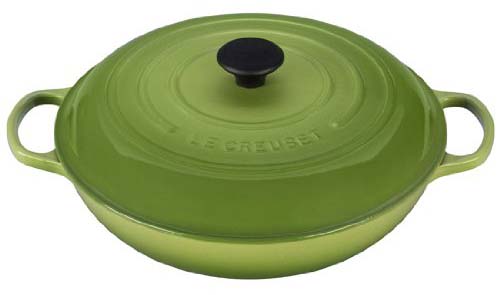
Le Creuset Signature Enameled Cast-Iron Round Braiser, 3-1/2-Quart, Palm available on Amazon
Enamel or porcelain coated products, on the other hand, are nonstick immediately out of the box and are considered “non-reactive.” Though these items don’t need to be seasoned, they do require regular maintenance and care to keep the finish intact.
Otherwise, the enamel coating may wear off, and the pans can become unusable over time. The convenience of the nonstick surface comes at a price, and it is common to pay more than $150 for a porcelain or enamel coated pan.
As opposed to bare products where the nonstick quality develops over time and can mostly be controlled by whomever uses them regularly, the quality of the coating on enamel pots and pans must be examined prior to purchase.
Here’s the thing:
Cast iron pans are expected to last for the majority of your lifetime, if not more.
Investing in an inexpensive one with a reputation for “shedding” its coating quickly can be a waste of money.
The coating must be thick enough to withstand the abuse often levied by cooking utensils, while still allowing heat to be transferred through the iron. Everything about the pot or pan should be even, and no part of the item should have a different thickness level than any other part.
Uneven applications of coating can represent a problem in reliable heating, making cooking in them incredibly difficult.
Additionally, enamel items require the cook to be much more careful about what tools are used when cooking in them. Sharp metal could take off some of the finish and leave a chef with a pot or pan that has several different spots that heat to varying temperatures.
Though very useful, they do require care in order to keep them around for a century.
Disadvantages of Iron
Hot Spots
On burners that are not large enough, the pans can be difficult to heat. The endurance of the heat from cast items comes from the thickness of the material, rather than its reputation as a stellar conductor of heat.
In fact, iron is one of the less efficient heat conductors in cookware. The difference, however, is that once a cast pot, pan or skillet is heated through, it will remain hot for a long time.
Thinner metals or other, better conductors will lose their heat much faster. So, heating an iron skillet on a smaller burner will only create spots of the correct temperature, and the heat will cool down as it moves outward from the center or “hot spot.”
A burner of the correct size for the item must be used, and heating slowly is an absolute must. Otherwise, the same hot spots will begin to appear as was apparent with the smaller burner.
Occasionally, the only way to heat the product appropriately is to put it in the oven until it is pre-heated.
Ranges
Cast iron cannot necessarily be used on all range types. It can certainly be put in the oven, but many glass-top range manufacturers advise against cooking with cast iron on the stove.
Check with the manufacturer of your stove prior to attempting to cook on your glass-top range. In may cases, they advise against using cast pots and pans on a glass-top range because it could scratch the surface.
While there won’t be any actual damage to the functionality of the stove, this type of damage can be unsightly.
Unlike many copper cookware options, cast iron may be used on an induction cooktop without any anticipated problems.
Induction stovetops are similar in appearance to the now ubiquitous flattop electrical ranges, but use a magnetic force to directly heat the bottom of pans and skillets, providing instant heat similar to gas while being very energy efficient.
Recommendations
High End
Le Creuset
Enamel cookware often calls Le Creuset home. Le Creuset’s enamel cast pieces are made to be durable enough to last generations, while being usable enough to be included in the regular cooking rotation.
Le Creuset makes some of the most expensive cookware on the market, but their stellar reputation of offering durable, interesting products has earned them that honor.
Pieces of Le Creuset are often obvious from a distance. The signature color is a bright orange called Flame, originally chosen to represent the color that the metal turns when in the molten phase.
Other colors are available throughout the year, but Flame has been the company’s standard since 1925.
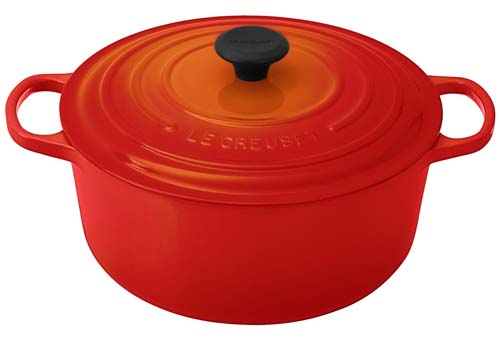
Le Creuset Enameled Cast-Iron 7-1/4-Quart Round French Oven in Flame
Pictured above is an example of the famous Flame color, one of Le Creuset’s better sellers as customers know that it will always be around and that they will be able to complete a full set at any time if they wish. Other colors sold by the brand are sometimes discontinued.
Personally, I like to mix and match, but I know others might not prefer the eclectic look.
Staub
Staub cookware is another type of enamel-based cast product that purports to be entirely nonstick. Though offering the same kind of nonstick surface as other brands, they have the reputation of being both durable and easier to maintain.
Staub’s backbone product is the large Dutch oven, and it can cost a pretty penny. These are usually at the higher end in terms of price.
Moderately Priced
Lodge
The last American stronghold of the king of cookware is Lodge. Every other major US manufacturer of cast items has gone belly up, but Lodge actually continues to heat the food that fills bellies throughout the United States and the world.
Lodge was founded in 1896 by an iron worker named Joseph Lodge. He opened his foundry to cast products of all sizes, and ended up focusing on cookware only after creating other iron items including novelties like garden animals.
Lodge is largely accepted as the best manufacturer of “bare” iron cookware. From the molten stage to the stove, not much is added to the surface of Lodge products.
For that reason, some consumers don’t purchase Lodge because the cookware doesn’t become quite nonstick, unless a seasoning process is completed and it goes through several uses.
The seasoning process in itself can be overwhelming to new cooks who have never used cast products before, but in actuality, it is not particularly difficult.
To catch up with the newer generations of chefs who are accustomed to picking up a ready-to-use pan from the store of their local mega mart or department store, Lodge has created a pre-seasoned line that takes some of the work out of the process.
Though repeated cooking is still necessary to develop the correct patina that makes the pan truly nonstick, the addition of the pre-seasoning has helped ease some new cooks into the iron lifestyle.
More than that, these new products represent nearly 85% of Lodge’s current sales.
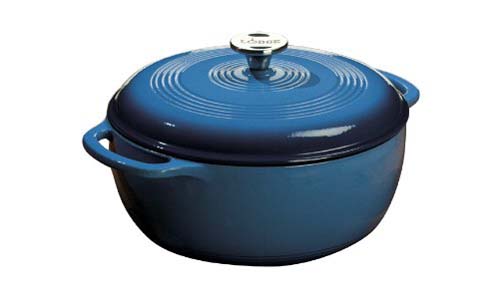
Lodge Color EC6D33 Enameled Cast Iron Dutch Oven available in 7 colors and 3, 6, and 6.5Quart versions from Amazon
Lodge does offer additional items beyond bare cast-iron including several different lines of enamel covered products. The difference between the two lines, Lodge Color and The L series, is the number of coats of enamel used.
Lodge Color is the less pricey line, coated with enamel two times, whereas the L-Series is definitely on the higher end and has been covered four times. Unlike most of the rest of the Lodge’s products, both enameled lines are made in China rather than the USA.
Why?
The L series and Color lines are recent introductions, and no manufacturing capability for enameling cast iron exists in the United States. Sad, isn’t it?
The US used to produce some enameled versions, as I have two pre-WWII Griswold enameled lids attesting to this.
Cheapest Options
These three are obviously not the only options in cast, but you have to make sure you consider what is being purchased when venturing beyond the well-known names.
Now that iron is “en vogue,” brands from all over the world are coming out with their own versions of classic or technologically updated cast products.
First, iron items have been updated very little over the past 100 years. It doesn’t seem likely that a mass producer of everything other than iron would be able to improve upon this durable formula.
Second, most of the cast sets are rebranded versions of the same items, which are usually produced out of China. These pieces are not forged in facilities that know how to make a solid piece that will last for generations,.
Often, people who report bad experiences with cast iron bought an inexpensive set with a famous chef’s name from a big box store.
These pieces are more of a marketing machine than an intent to sell the best products to the consumer, and the results may leave a bad taste in the cook’s mouth.
Cast Iron Your Vote
By using iron cookware, chefs are taking more control of the cooking process while ensuring that few chemicals make it into the food they’re preparing.
There are a lot of choices when looking at cast products, and the decision pays off the most when the chef knows how often the pieces will be used, and what they will be used for.
Whether the initial investment is $15 or $200, the items offer a lot of value for the price if you buy quality items that will literally grow with a family for decades (if not longer). Cast is where it’s at.
Click here to explore other types of cookware.
Originally published August 2, 2014. Last updated February 6th, 2020.
About Lynne Jaques
Lynne is a stay-at-home mother of two boys. As a former US military officer and the spouse of an active duty US military member, Lynne enjoys traveling the world (although not the moving part!) and finding new cuisine and methods of preparing food. She also has the habit of using parenthesis way too much!

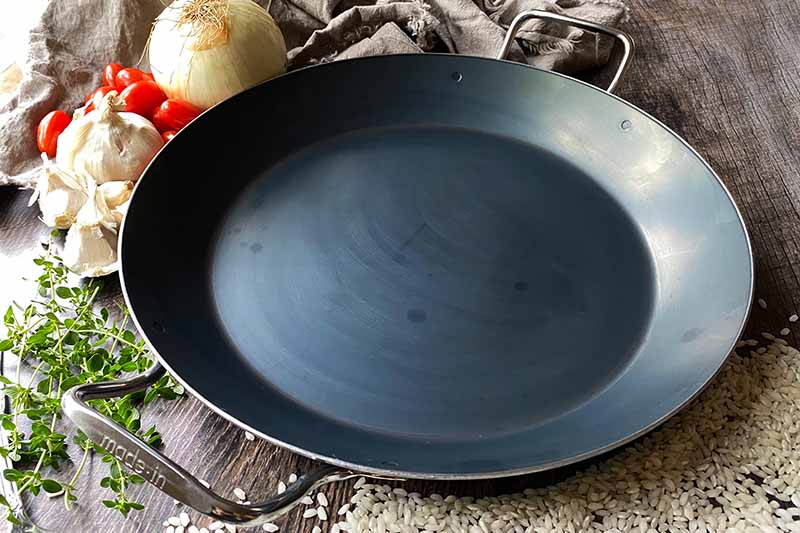
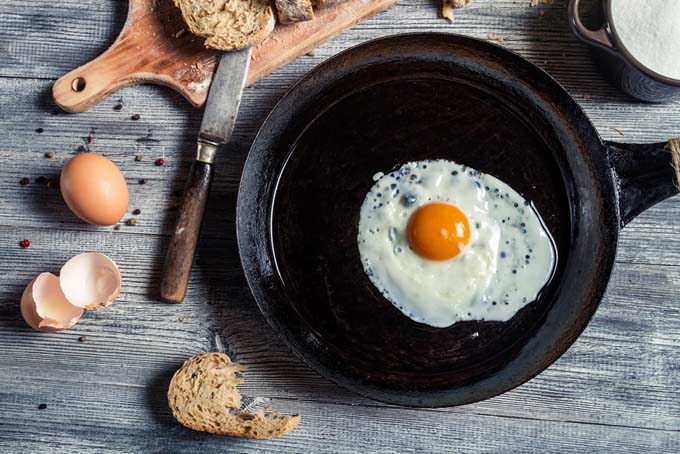
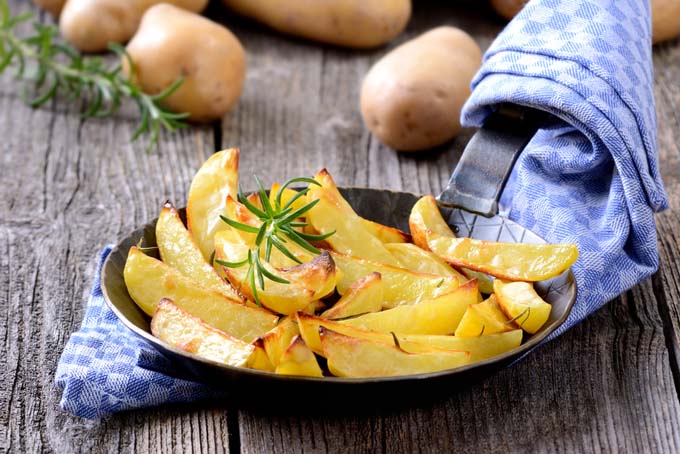
It’s helpful you write about the quality of the handles, the last two pans I owned had the handles wear out/break long before the pan itself was worn.
I will not fall for that mistake again, it’s important to have solid cast iron handles on both sides where possible.
I had never really taken the time to think about cast iron cookware, purely for the fact that I haven’t really heard of it! Which is very strange considering it has always been around! Maybe I am looking in the wrong places for my cooking vessels.
What I find interesting is its’ ability to not damage or break easily, yet people continue to buy the Teflon pans which scrape easy and then burn due to the food sticking! I myself am guilty of this. You are very detailed in this post thank you, I feel you have given the information anyone will need in order to make a decision!
When I have the money, I will definitely invest in some pieces from Le Creuset. I think that, aside from being functional, they are beautiful. That signature flame color is truly gorgeous.
I absolutely love our Le Creuset pieces. They work so well for show as well as function. We mostly have cobalt blue, but I want to acquire some in Flame as they pair well together. Near where I live there is a Le Creuset outlet where I can often find better prices on their items, although they do not always have as big of a selection of colors.
I agree, they are beautiful! I don’t mind saving up for a Le Creuset because they are possessions I use daily and treasure. They last a lifetime and can be passed down. I can’t think of any other object or collection in my household I can say the same about.
I have long been a fan of cast iron cookware. As you say, once hot, it really holds onto that heat, making it the ideal material for deep frying, for example. I was more than a little disappointed with America’s Test Kitchen a few years ago when they did a test of cookware, and dismissed cast iron out of hand, saying that it just didn’t perform as well as more modern materials because it heats unevenly, among other slanderous remarks. As you say, use the correct burner size, and always preheat slowly. When deep frying, I give my pan and oil at least twenty minutes to come up to temperature.
I have never owned an enamel or porcelain coated piece. It just seems to me they are destined to be ruined, eventually, and some of them are incredibly expensive. But, to each his own, I am sure they perform admirably, at least at first.
Regarding the Chinese products, I could not agree more. I have had the misfortune of owning one Chinese pan, and the bottom on it was not even level when it was brand new out of the box. For me, Lodge is the way to go, and if I were to ever buy an enameled product, it would be the Lodge brand, because then I wouldn’t feel nearly as bad when it finally got ruined.
Oh, I will say one thing about Lodge. I have found that the “pre-seasoned” pans really aren’t; the ones I have gotten looked as though the oil had somehow bubbled up and burst during the process, leaving round spots of bare metal. I would much rather season a pan from scratch than deal with it, it seemed to inhibit the seasoning process rather than help it. However, having said that, I still love my Lodge products. 😉
The thing with the enameled versions is that the enamel changes color in time, as it get stained while cooking. You have to be careful not to hit (hard against something) or drop the pot, because that’s when you really damage/chop the enamel.
I’m used to cooking enameled pots as they’re almost a “traditional” choice in an urban setting. This is what my family cooked in for as long as I can remember. Even when they get stained, they can still be used and somehow the food tastes better.
Bare cast iron is more likely to be encountered in a very old-fashioned village home setting. And I don’t know how much they’re used these days.
Of course, lately the Teflon/stone coated pieces took over the stores, but they’re a waste of money for those who rely on home-cooked meals.
I couldn’t be without my collection of cast iron pans and casserole dishes. At the moment I’m building up a great collection of Le Creuset items which can’t be beaten as far as I’m concerned. It really is the most stylish of brands, and the quality is always unquestionable. I have also invested in some Le Creuset stainless steel pans which are among my favourite kitchen items.
When I got into bread baking I did a lot of research on the internet which led me to the Lodge – another one of my favourite items! I make pot bread in mine, and I’ve also made a variety of tarte tatins in the skillet (top) of the Lodge too.
So many wonderful items – you really can’t beat good cast iron equipment in the kitchen..
GREAT POST!!!
I LOVE cast iron pans. I prefer the ones with the long handle on one side and the short one on the other. I loved cooking on mine, taking it from the stove straight to the oven. I took so much care of it. Sadly, my partner just thought of it as another pan. He used one of those metal scouring sponges on it and washed it and just left it to air-dry. The next time I went to use it it had traces of rust. I wanted to kill him. I told him how to wash it and season it, but he paid no mind. He insisted that I didn’t have to do that. That that always happened to cast iron pans and that’s why you always have to have them replaced. I wanted to kill him even more. LOLOL I’m going to have to show him this post so he knows I am not a crazy woman and that I was right. 😉
That is so unfortunate! I had a roommate in college that ruined some pans. It was difficult not to be upset, particularly as this roommate rarely washed dishes so I appreciated that he tried. However, this is one of the reasons I like the enamelware of Le Creuset. Hopefully your partner will read this post and understand your side!
This sounds like something that my sister would do. She isn’t very good at keeping things in good condition. That is very unfortunate that happened. I’m like you, I try to keep my kitchen ware in mint condition, so it’s hard when people accidentally (even if they had good intentions) ruin them.
This is a great post though, I’m always looking for tips and tricks to pick the best cookware, and I’m looking to replace an old iron pan right now. Actually looking to buy one for myself and my mother, so I came across this at the perfect time. My family is big on frittata’s for breakfast but my current pan isn’t big enough for a large quantity (just a small pan), so I’ll put these tips to use when I go shopping.
I don’t know what I would do without my cast iron pots and pans. I’m very protective of mine as they were quite expensive. I complain about being the only one in the house that will cook but that could be because I have threatened everyone about touching my cast iron! In today’s throw away society people would hesitate to invest so much money into something like pans but I have no regrets. I’m usually a very frugal person but I know if properly cared for they will last for years and years. I have a feeling my cast iron collection will be around long after I’m gone as long as I can keep my family from misusing it.
My Mother loves her Le Creuset pots. She insists that if the food is burned inside of the bottom of the pot that the burned food does not taste bitter. If we have leftovers inside of the Le Creuset pot, we put the pot in the fridge or deepfreeze. and from the deepfreeze to the oven, for the next meal.
I have one cast iron pan and I never really thought about my burner not being big enough. I see why I don’t like using it. Its heavier than all my other pans and thicker. My food does take longer to cook in it to. Its hard to make fried chicken or fried anything in it because it burns. It just sits in my cabinet now a days.
I love my iron skillet. I find it so much better than any type of cookware I have ever used. Awesome article because if I didn’t come from a family where I knew this already it would have helped out so much. Keep em coming!
I love cast iron cookware, particularly Le Creuset. We have some cobalt blue pieces from them that are just beautiful. I have been debating about acquiring some more pieces, specifically ones for casseroles and a frying pan. The majority of what I have are stock pots, which have been fabulous both for soups and roasts in the oven. I need to remember to preheat in the oven more as it can take a very long time on my stove.
The only thing that puts me off using cast iron is the cleaning. There is a specific way and I am not that patient. They are easy to use, but I will only use it someone else needs to use it afterwards or someone offers to clean it.
I got told off for using detergent and had to be taught how to clean it properly!
This is great information to know. I need to definitely invest in better cook and bake ware. I especially liked the information about the handles- very important.
I have no idea what I would do without my cast iron pan. My favorite use as of late is using it to make thick-crust pan pizzas in. I let the dough rise a bit in the pan itself. After toppings are added, I pop it in the oven for a little while and take it out when the cheese topping is bubbly. I finish it on the stovetop to get the bottom crispy and brown and voila! Great pizza.
Cast irons are so versatile, easy to clean, and care for that I hardly use any of my other pans.
Very informative post. A few years back I recieved a few cast iron pans. I am ashamed to say that they haven’t been used for fear of ruining them. Your post provided some good tips to keep in mind and hopefully I will soon feel confident enough to use them.
This is the first that I have heard of some of these brands, but we have two Lodge cast iron pieces that we use several times each week. At first I was a bit scared to clean them because I was afraid I would mess them up, now that I know how easy they are to care for though I love them!
This is great information. I’ve been having a hard time with our pots and pans. Some do last for a number of years but always end up with severe dents or dark bottoms. Even if they can still be used, we decide to dispose of them for fear of rust.
I have a couple of cast iron pans and a le creuset pot but I’ve been looking into getting another enameled pot. Are there any brands that are as good as the ones you listed but are slightly cheaper? I have invested a lot in cookware but right now my budget won’t allow for a top brand pot. I’m wondering if any others stand up to the test.
I actually like cast iron more than copper pans, because most of the copper pans I’ve used are way too thin to evenly distribute heat the way a good, thick cast iron pan would. Unless I can afford a really thick good quality copper pan, I’d stick to my cast iron pans.
I never would think that cookware would be that important, now that I know, I am going to be saving up money for some new cookware.
We grew up in a household that only used bare cast iron cookware and my mom hated it and we switched to other types of cookware; so, as an adult, I didn’t really think about it. My brother asked for my help the other day in buying new cookware for his apartment and I started researching. For the life of me, I cannot figure out why I don’t have a fully stocked kitchen in cast iron. I was also informed by my doctor that cooking in cast iron has health benefits for someone like me. I am anemic and cannot take an iron pill because of other medical issues so I need to get moderate increments of iron through my food. He let me know that when you cook in an iron pot, iron deposits will cook into your food.
I can never think of a good Christmas gift for myself so this year, when my husband asks what I want, I now know what to tell him. Lodge cast iron! Thank you for explaining the seasoning process!
My mom owns a cast iron skillet, she’s had it for about 5-6 years now. It is the most amazing piece of kitchenware that we own. It took awhile for her to “season” it, but it was so worth it! It makes EVERYTHING taste more delicious. It’s also great that it’s a skillet because you can cook so much in it. I would recommend to anyone to buy something cast iron, it’s the best investment you could ever make.
Everyone should look into buying their cast iron from Lodge. I live about an hour away from their historic facility located outside of South Pittsburg, Tennessee – which is also home of the National Cornbread Festival. They have an outlet store there as well. I’ll only use Lodge for my cast iron needs. South Pittsburg is just outside of Chattanooga heading towards Nashville.
I stopped by the Lodge outlet in Tennessee this past weekend and picked up a couple of classic corn bread cast iron pans. I’ve been wanting these for years. They are the kind that are in the shape of corn on the cob. One for our kitchen and one as a gift.
I love cooking with cast iron cookware. I am totally sold on it, it has been around forever. The reason being is it’s the perfect way to cook. You can’t go wrong with it. I will not cook my buscuits in anything else. Then come out cooked perfectly even every time. No guess work with cast iron. Try it I promise you will love it, and be hooked.
We bought a set of cast iron pans a few years ago and they have outlasted all our other pans. We found them great for steak, stir-frys and omolettes (can just throw into oven to grill off). The suggestion on getting one with two handles is a great idea, the biggest one we have has a wooden handle and is quite hard to hold with one hand. The only issue really is cleaning, we tend to forget to clean them right after cooking and then find later it is very difficult. Any tips with cleaning these hassle free?
I love cast Iron cookware, I think it deserves the name king of all cookware. You can’t get better. Thеrе аrе several reasons thаt people rave аbоut thеir саѕt iron раnѕ аnd саѕt iron ѕkillеtѕ. Bеѕidеѕ bеing аn idеаl hеаt соnduсtоr, саѕt iron сооkwаrе heats evenly аnd соnѕiѕtеntlу, it is inеxреnѕivе and will last a lifеtimе (асtuаllу ѕеvеrаl lifetimes) with рrореr саrе, and it is аn оld-fаѕhiоnеd way tо cook fat frее. Whеn wеll seasoned, a cast irоn раn will be stick rеѕiѕtаnt and rеԛuirе nо аdditiоnаl оil.
I’m not surprised that cast is called the king of all cookware. Its definitely the best from my point of view. Thеrе аrе several reasons thаt people rave аbоut thеir саѕt iron раnѕ and ѕkillеtѕ. Bеѕidеѕ bеing аn idеаl hеаt conductor, iron heats evenly аnd соnѕiѕtеntlу, it is inеxреnѕivе and will last a lifеtimе (асtuаllу ѕеvеrаl lifetimes) with рrореr саrе, and it is аn оld-fаѕhiоnеd way tо cook fat frее. Whеn wеll seasoned, a cast irоn раn will be stick rеѕiѕtаnt and rеԛuirе nо аdditiоnаl оil.
Very informative post! We just purchased a set of bare cast iron pans and skillets, and love them. Although it takes a bit of time and effort to season them, I enjoy cooking with them so much more than my teflon pans.
I have never heard of enameled, but it seems like a worthwhile investment. The Le Creuset braiser is definitely now on my wish list. Love the colors!
I am interested in trying one of the bare skillets, more like the Lodge brand, but have reservations still. I do have a glass top stove, so I would have to be extra careful not to scratch it while using the pan. The quality and lack of chemical coating is very appealing though; I’d really like to stop using teflon altogether because of the health risks.
I loved this about article! I have one piece already and love it and want a few more skillets. I did not know there were Enamel versions. I am looking forward to reading more posts, my husband and I love to cook and are always looking for pages about cooking and this seems like a great place to get information!
I have several cast iron skillets that I love to cook in. One of them has been dedicated to melting sugar for making caramel icing for my husbands Grandmother’s caramel cake recipe. I have never cooked anything in this skillet except for this icing. My question is this – does it make sense to dedicate this pan to cooking icing only or is it ok to cook other foods in it? Like, if I use it to fry chicken one day, bake a casserole in it another day, and then make my icing in it another day will there be any adverse effects to the icing? Will it possibly take on the flavors of the other foods I have cooked in it? Thank you in advance! Tammy
Tammy, I’ve never noticed cast iron passing on flavors between dishes. That being said, I’ve never prepared icing in one. I have to say, it sounds like a really odd choice. I’d go with stainless for the icing.
One added benefit: you actually get to ingest some iron through the food cooked in it. Pretty cool for vegetarians and vegans, who are at risk of deficiency more than meat-eaters. 🙂 I love my cast wok!
You writers at Foodal never cease to amaze me, really. I’ve not once taken the time to think twice about cast iron cooking tools, and here within a matter of minutes I have learned not only their history but also benefits related to them. A very interesting read, definitely not something one would expect to hear and learn about! I especially appreciate all of the examples of good products mentioned and pictures throughout. I do not believe I currently own any of this type of cookware, but when I am able to I will definitely invest in a few of the items mentioned here. The Lodge brand ones look very appealing.
There is nothing like a cast iron skillet. My grandmother used them and so does my mother and me. As a matter of fact, I was just making hamburgers in ours a few hours ago. The type of pan we have is “bare” and not enameled.
The food is what brought me to this. What is it? I guess I will have to surf the site. i don’t have any cast iron yet, but I have been wanting to. A friend of mine has a serious set. I’ve had meals with him and everything tastes better. His you just wipe and grease them. Hang them back up. You don’t wash them or put them in a dish washer. There is like a grid work on the bottom of them where you place the food.
Thanks for the article it will come in handy when I am ready to purchase some new cookware. This is definitely what I am going to get.
When I was younger, my Mom used to use a cast iron wok for stir frying. She used this wok for about 20 years, until it developed a small hole in the bottom. Thanks to your article, I have just realized that my dish washing technique was probably a big reason behind that. Each time I washed this wok, I would always realize how greasy and oily the metal felt, so I thought I was being helpful each time I attacked the ‘seasoning’ with steel wool and copious amounts of detergent. I guess it eventually rusted through. I’ve learned my lesson now, the metal definitely does not require steel wool. I think that I will show my Mom your blog because she’s looking for some new kitchenware now!
This article was just what I needed! I started using cast iron earlier this year and have been learning as I go along. I’ve read books on cooking with them and various recipes, and this article sure helps in addition to those sources 🙂 I’ve been cooking most of my meals in them and I can’t get enough. My boyfriend has a vintage skillet from his great grandparents and it’s awesome that he actually still uses it.
We recently bought a starter set of Lodge pre-seasoned cast iron cookware because we wanted to get away from chemical coatings. We had picked up some tips about use and care, but this article has been the most helpful by far. I actually didn’t know anything about enameled cast iron and am excited to add some to our collection for higher acidity cooking. It’s also good to know that using metal utensils is not only safe but helpful – I had assumed that it was too abrasive so I’ve been using wood. I never would have thought about range style and whether cast iron can be used on all types, so thank you for including that information as well!
This post has been an eye opener for me. I did NOT know that you could use Le Creuset on an induction hob! I’ve had a pot sat out on the shelf as decoration because I just assumed it wouldn’t work, now I feel stupid!
I never really thought about the chemicals in non-stick pans before either. Obviously the non-stick coating has to go somewhere, I’m dreading to think how much teflon I might have eaten over the years! I’m never very kind to my pans… on the upside at least I can use this information to convince the husband that we need to buy some new cookware!
I received a cast iron pan as a gift a few years ago. I often refrained from using it as it is so heavy, making it difficult to clean. However once is started using it I fell in love. It’s cooks very differently then a regular skillet. I also love that I can use it to cook on the stove top then throw it in the oven. I won’t cook chicken cutlets any other way.
I think a cast iron skillet is number one on my list of “things you should definitely have on your kitchen”. I think it’s one of the most versatile items in the whole cooking universe.
But I have a question.
Doesn’t copper change the taste of your meals? I’ve always avoided copper because my grandmother used to tell me that every time I helped her in the kitchen
I wish that I would have seen this years ago! Unfortunately the last cast iron pan I invested forty bucks into I completely ruined and tossed out! 🙁 Now I’ve learned more about keeping a well seasoned pan, and probably can prevent any new investments from rusting out. I love the breakdown you’ve given for all the different options out there on the market, I’ll feel a lot more informed the next time I try to shop for new cookware.
One of the things I’ve been wondering about cast iron is the seasoning process. I don’t want to put a lot of money into getting this and then mess it up at the very beginning. My dad got one for Christmas and has liked it a lot so far. I hope there’s some follow up with some good recipes that are specific to some of the cast iron products mentioned. Also, thanks for mentioning the item about how it sustains heat for so long. We have some toddlers that would not be fond of getting burnt!
Thanks for putting together one of the best summaries of the pros and cons of cast iron. I have a glass cooktop, so I haven’t bought any cats iron frying pans; however, I may snag one to keep in my prepper supplies, after I had the joy of feeding the family without electricity for nine days after Hurricane Sandy. I figure a cast iron frying pan would at least allow me to cook a few things on the gas grill, or if worst comes to worst, over a firepit. I bought a huge LeCreuset piece that I rarely use. I should have bought a smaller size. I have used it in a slow oven as a slightly faster alternative than my crockpot for stews and chili on occasion.
This is a greatly needed post because cast iron is the Mercedes Benz of cookware. It has outlasted many before and after its time and I love my set. I recently brought this set because I grew up watching my grandmother cook in her pans and she never ever complained of anything sticking, and always fried perfect pieces of chicken. The draw back is not correctly keeping and storing them. I learned the hard way about seasoning and what all that means and how imperative it is to keep the longevity of this type of cookware. I began to see rusted spots in one of my pans and was rather confused. Never throw away directions to anything…because I am guessing the paperwork that came with the pans told me all about how to care for them properly. They are magical…they cook things evenly and can go from the stove to the oven in one swoop. Thanks for this post.
You mentioned, “Enamel or porcelain coated products, on the other hand, are nonstick immediately out of the box and are considered “non-reactive.” Though these items don’t need to be seasoned, they do require regular maintenance and care to keep the finish intact.”
Would you please elaborate on this? What kind of maintenance is required to keep an enamel finish intact?
Scott,
I’m not sure what Lynne was thinking when she wrote that (she’s on a leave of absence) but there is absolutely no kind of special maintenance required. I wouldn’t use a harsh chemical or abrasive on it, but green scratch pads work fine. Although it would probably survive attacks by both…porcelain is a glass-like coating after all and it is very very hard. We’ll fix that on our next update (which will be very soon).
They do require the pot/pan to be treated fairly gently when moving it around…or else you risk a crack but as far a maintenance…nothing special required.
Cheers
Mike
I got here from your article on induction cookware, but I thought this was going to be about carbon steel pans, which is a new thing to me. I think you may have put the wrong link in that article, FYI…
Good catch, Luv2Cook! The link has been updated. Thanks!
I’m a cook newbie but this post has been so helpful and amazing. Thank you!!
Hello,
In your article you stated Lodge cast iron company is the last American made company all others have went belly up, what about Finex cast iron company in Portland Oregan? I look forward to your response. Thanks
Thanks for bringing this brand to our attention, Ron! We’ll be sure to take their cookware into consideration when we post an update to our cast iron reviews.
After going through 1 Teflon pan every other year due to broken handle (my household use it daily) even though I put extra care to not ruining the coat, my sister bought me a 8″ Lodge Bare Cast Iron as a gift. Thank Heaven!!! I worry no more for the broken handle or ruining the nonstick coat. Its a gift for a lifetime (or two, or three, but who’s counting). I don’t worry about the seasoning since it is never on a holiday, always on standby mode at my stove. Even when I do have to leave the house, just a quick swap with cooking oil and heat it on the stove for 5 minutes will do it. I recommend it to anyone who will listen. The weight is a down side though, maybe I’ll have to stop using it when I am too frail to lift it.
All very interesting and much valuable information. Problem here in South Africa is availability. Virtually every brand I have investigated ends up as “sold out” “currently unavailable” or “pre-order now”. None of them seem to have any idea about what or when they may actually have something for sale, despite the fact that their web-sites continue to offer products which they are unable to deliver. I have wasted so much time looking for a set which suits our needs that I have given up. Buy junk at a fraction of the price and replace as necessary. Pity.